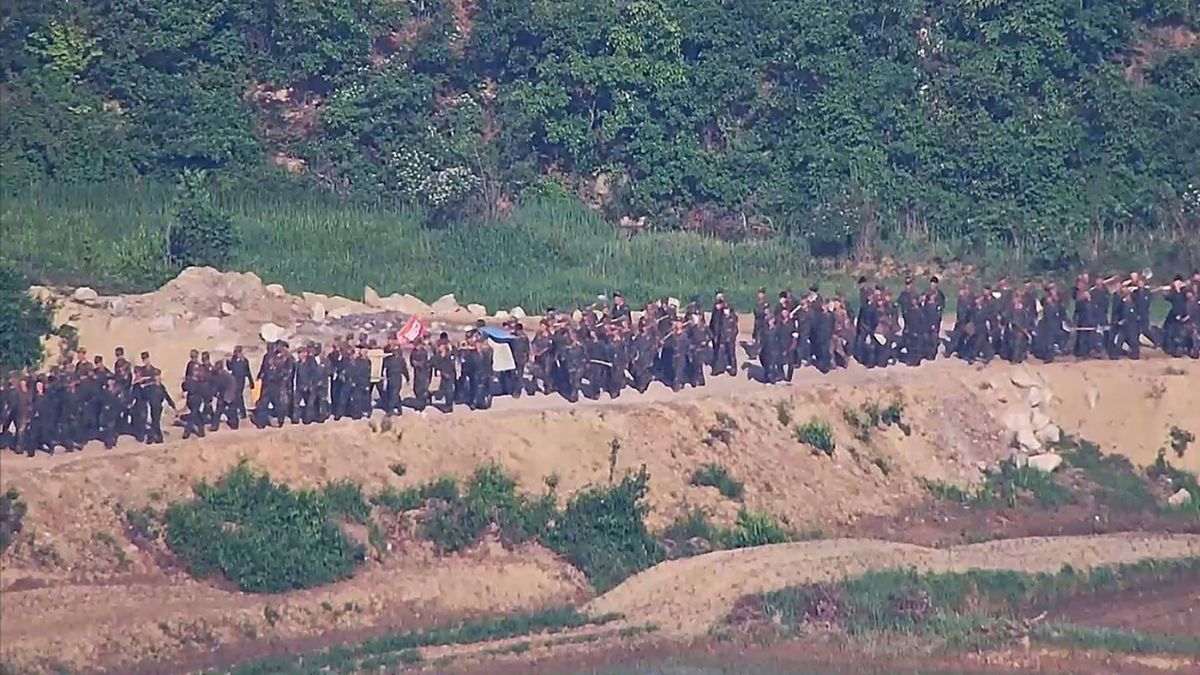In the third incursion this month, North Korean soldiers briefly crossed the heavily fortified border Friday, forcing Seoul’s military to fire warning shots in retaliation. The nuclear-armed North has been reinforcing the border in recent months, adding tactical roads and laying more landmines, which has led to “casualties” among its troops due to accidental explosions, South Korea has said.
Relations between the two Koreas are at one of their lowest points in years, with Kim Jong Un hosting Russian leader Vladimir Putin this week, and signing a mutual defence agreement that has raised hackles in Seoul. In response, the South – a major weapons exporter – has said it will “reconsider” a longstanding policy that has prevented it from supplying arms directly to Ukraine.
What happened?
On Friday, South Korea’s military said it had fired warnings shots the previous day to repel several North Korean soldiers who briefly crossed the military demarcation line that divides the countries while engaging in unspecified construction work. Similar incidents took place on June 9 and June 18, each involving some 20 to 30 North Korean soldiers briefly crossing the demarcation line and retreating shortly after the South Koreans broadcast audio warnings and fired warning shots.
South Korea’s military says the incursions were likely accidents, noting that the North Koreans did not return fire and withdrew immediately.
What does the demarcation line look like?
The demarcation line, in many parts of the DMZ, is simply a sign mounted on a stick or a slice of concrete.
People have stepped across it before, under very special circumstances, and usually at the border village of Panmunjom. Former U.S. President Donald Trump walked across with Kim Jong Un. Last year an American soldier facing possible military discipline dashed over the line to the North.
Outside of Panmunjom, much of the DMZ is wilderness, but it is heavily monitored on both sides. And while the demarcation line may be easily crossed, it is very difficult to do so without being spotted immediately.
Impact Shorts
More ShortsThe southern side of the land border is protected not only by thousands of soldiers, guns and mines, but also by a dense network of cameras, motion sensors and other high-tech surveillance equipment. Breaches are very rare and are usually detected quickly. Defections from the North are also unusual along the North-South land border, though they have happened with frequency along the porous China-North Korea border and occasionally in the Yellow Sea.
The North’s accidental intrusions this month may have been caused by a sudden jump in North Korean troops fortifying their side of the border.
Because overgrown trees and plants may have been obscuring the signs marking the demarcation line, Seoul says, the North Korean troops may have stepped over the line without knowing it.
Why are so many North Koreans working in the DMZ?
Relations between the rival Koreas are worse now than in many years.
Recent weeks have seen a tit-for-tat standoff that has resulted in Cold War-style psychological warfare. Both sides have said they are no longer bound by a landmark military agreement in 2018 to reduce tensions.
The North Koreans along the border, Seoul says, have been installing what appear to be anti-tank barriers, reinforcing roads and planting land mines, even as mine explosions have killed or wounded an unspecified number of North Korean soldiers.
The construction started around April and may be an attempt to curb North Koreans trying to defect to the South, according to Seoul’s military.
Animosities may worsen as Kim continues to accelerate his nuclear weapons and missiles development and align with Russian President Vladimir Putin in the face of their separate, escalating confrontations with Washington.
On Thursday, South Korea’s government condemned an agreement by Kim and Putin at their summit this week in which the two nations vowed to aid each other if attacked. In turn, Seoul said it will consider sending arms to Ukraine to help it fight Russia’s invasion.
Could it happen again?
Possibly, especially if the North Korean construction continues along the demarcation line.
But both sides appear intent on containing their animosities to the psychological warfare they’re engaging in.
Still, there are worries that the hostilities are pushing them closer to a direct military clash. The Koreas have had no meaningful talks for years and could find it difficult to set up dialogue as tensions rise over the North’s development of nuclear-capable weapons.
Some analysts say the Koreas’ poorly marked western sea boundary — site of skirmishes and attacks in past years — is more likely to be a crisis point than the land border.
Kim, during a fiery speech in January, reiterated that his country does not recognize the Northern Limit Line in the Yellow Sea, which was drawn up by the U.S.-led U.N. Command at the end of the war. North Korea insists on a boundary that encroaches deeply into South Korea-controlled waters.
While the huge military presence on both sides of the DMZ means that years sometimes pass without incident, violence can quickly erupt. Two American Army officers were axed to death in 1976 by North Korean soldiers, for instance.
With inputs from agencies.
)